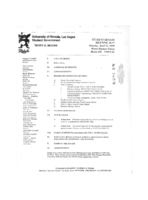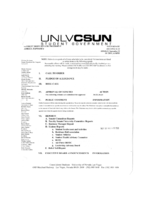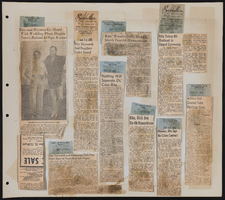Search the Special Collections and Archives Portal
Search Results

Transcript of interview with Judith Ann Allaire by Tracye Ann Collins, March 10, 1980
Date
1980-03-10
Archival Collection
Description
Tracye Ann Collins interviews teacher Judith Ann Allaire in her classroom at Valley High School in Las Vegas, Nevada. Allaire was born in Chicago, Illinois on March 24th, 1944, and relocated to Las Vegas, Nevada in 1955. This interview covers education, growing up in Las Vegas, and politics in Nevada. Allaire also discusses the various job titles she has held, such as medical social worker, secretary, cocktail waitress, drug counselor, dancer, and teacher, in Las Vegas, Nevada.
Text

Meeting minutes for Consolidated Student Senate University of Nevada, Las Vegas, April 13, 1998
Date
1998-04-13
Archival Collection
Description
Includes meeting agenda and minutes. CSUN Session 28 Meeting Minutes and Agendas.
Text

Meeting minutes for Consolidated Student Senate, University of Nevada, Las Vegas, June 30, 2008
Date
2008-06-30
Archival Collection
Description
Includes meeting agenda, with additional information about CSUN Code of Conduct. CSUN Session 37 Meeting Minutes and Agendas .
Text

Meeting minutes for Consolidated Student Senate, University of Nevada, Las Vegas, May 01, 2006
Date
2006-05-01
Archival Collection
Description
Includes meeting agenda. CSUN Session 36 Meeting Minutes and Agendas.
Text

Meeting minutes for Consolidated Student Senate, University of Nevada, Las Vegas, September 25, 2006
Date
2006-09-25
Archival Collection
Description
Includes meeting agenda, along with additional information about letters. CSUN Session 36 Meeting Minutes and Agendas.
Text

Program from event commemorating retirement of Leo Wilner as Executive Director of Temple Beth Sholom, 1984
Date
1984
Archival Collection
Description
Program booklet for the testimonial dinner held for Leo Wilner's retirement includes dedications from colleagues and friends.
Text
Pagination
Refine my results
Content Type
Creator or Contributor
Subject
Archival Collection
Digital Project
Resource Type
Year
Material Type
Place
Language
Records Classification




